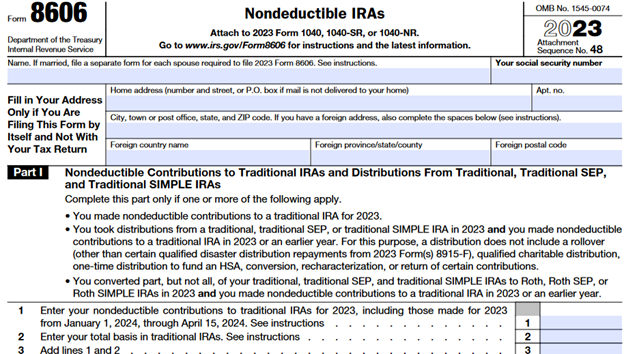Understanding a “Backdoor” Roth IRA Including Advantages and Tax Implications

It needs to be emphasized that the “backdoor” Roth IRA strategy is not a tax dodge. On the contrary, the backdoor Roth IRA strategy is a legal way to get around the income limits that prevents high income individuals from contributing directly to a Roth IRA.
This column explains in easy-to-understand terms what a backdoor Roth IRA is, including its advantages and tax implications.
Understanding the Differences Between a Traditional IRA and a Roth IRA
A Roth IRA allows an individual to contribute to a retirement savings account. The contributions to the account are made with after-taxed dollars. Once contributed to the Roth IRA account, the after-taxed funds grow at least tax-deferred. But the entire amount of the Roth IRA – including contributions and accrued earnings – can be withdrawn tax-free if the Roth IRA owner is over age 59.5 at the time of the withdrawal and it has been at least five years since January 1st of the year the Roth IRA owner made his or her first Roth IRA contribution.
On the other hand, a traditional IRA gives the owner an immediate tax break because contributions to a traditional IRA result in a tax deduction (in particular, an “adjustment to income”) in the year the contributions are made. No taxes are due with a “deductible” traditional IRA until the traditional IRA funds are withdrawn sometime after the traditional IRA owner becomes age 59.5.
Ed Hosts an Informative Tax Planning Webinar for Federal Employees-
Individuals whose annual gross income exceeds certain amounts are not allowed to contribute to a Roth IRA. If an individual’s modified adjusted gross income (MAGI) exceeds a statutory ceiling, then IRS rules result in a “phasing out” of the amount that the individual can contribute to a Roth IRA in that year. Above the annual statutory MAGI ceiling, the individual cannot contribute at all. The MAGI limits by tax filing status for the year 2024 are:
- Single and Head of Household tax filers: Between $146,000 and $161,000.
- Married couples filing jointly: Between $230,000 and $240,000.
- Married couples filing separately: Between $0 and $10,000.
Traditional IRAs do not have ceilings for participation (contributions). Since the year 2010, there have also been no income limits with respect to who can convert a traditional IRA contribution to a Roth IRA. As a result, the “backdoor” Roth IRA has become a tax-planning opportunity for high-income individuals who, due to income limitations, cannot contribute directly to a Roth IRA.
There are individuals (including most federal employees) who are ineligible to make deductible contributions to a traditional IRA. They are allowed to use after-tax dollars to contribute to a traditional IRA and therefore the traditional IRA is classified as a nondeductible traditional IRA rather than a deductible traditional IRA. A nondeductible traditional IRA is similar to the Roth IRA because all contributions are made with after-tax dollars. However, when funds are withdrawn from a nondeductible traditional IRA, the nondeductible traditional owner will pay income tax only on the accrued earnings.
How to Create a “Backdoor” Roth IRA
The custodial bank or brokerage of one’s traditional IRA should be able to help the traditional IRA with the mechanics of creating a “backdoor” Roth IRA.
Tax Implications of a “Backdoor” Roth IRA
For example, if an individual contributes $6,000 to a deductible traditional IRA, claiming a deduction for the $6,000 on the current year federal income tax return, and then immediately converts the $6,000 to a Roth IRA, then the individual will owe tax on the $6,000.
But through the years most of the traditional IRA contributions were deductible (pre-taxed). If the traditional IRA has accumulated earnings or made investments that have appreciated over an extended period, most of the funds and investments that were converted to a Roth IRA will count as taxable income in the year of the conversion. That could result in the converted Roth IRA owner being pushed into a higher marginal tax bracket in the year of conversion.
However, if some of the contributions to the traditional IRA were made with after-taxed dollars (nondeductible contributions), then the IRA owner may not have to pay tax on all of the converted funds. A pro-rata rule applies to prevent taxing the amounts attributable to after-taxed contributions.
A traditional IRA owner who makes a nondeductible condition to a traditional IRA must notify the IRS that the funds used to contribute to the traditional IRA were already taxed. The IRA owner does so by filing IRS Form 8606 (Nondeductible IRAs) with his or her federal income tax in any year a nondeductible contribution is made.
A portion of IRS Form 8606 for the year 2023 is shown here:

Benefits of a “Backdoor” Roth IRA
- Roth IRAs do not have required minimum distributions (RMDs) which mean that a Roth IRA can grow tax-free for as long as the Roth IRA owner is alive. The Roth IRA owner can withdraw tax-free as much as or as little as he or she wants or can leave it all to his or her heirs.
- “Backdoor” contributions can result in significant tax savings over decades because Roth IRA distributions, unlike traditional IRA distributions, are not taxable.
- A “backdoor” Roth contribution can mean significant tax savings over an extended period of time because backdoor Roth IRA contributions are made on converted pre-taxed funds after which grow tax-free. The tax benefit is greatest if the “backdoor” Roth thinks that his or her income tax rates will rise in the future.
Federal employees and retirees who have problems or additional questions about the “backdoor” Roth IRA are advised to speak with their tax advisor or to contact a financial professional who is familiar with “backdoor” Roth IRAs and works on regular basis with individuals creating “backdoor” Roth IRAs.
*Unless certain criteria are met, Roth IRA owners must be 59½ or older and have held the IRA for five years before tax-free withdrawals are permitted. Additionally, each converted amount may be subject to its own five-year holding period. Converting a traditional IRA into a Roth IRA has tax implications. Investors should consult a tax advisor before deciding to do a conversion. Investing involves risk and you may incur a profit or loss regardless of strategy selected.
Edward A. Zurndorfer is a CERTIFIED FINANCIAL PLANNER™ professional, Chartered Life Underwriter, Chartered Financial Consultant, Chartered Federal Employee Benefits Consultant, Certified Employees Benefits Specialist and IRS Enrolled Agent in Silver Spring, MD. Tax planning, Federal employee benefits, retirement and insurance consulting services offered through EZ Accounting and Financial Services, and EZ Federal Benefits Seminars, located at 833 Bromley Street - Suite A, Silver Spring, MD 20902-3019 and telephone number 301-681-1652. Raymond James is not affiliated with and does not endorse the opinions or services of Edward A. Zurndorfer or EZ Accounting and Financial Services. The information has been obtained from sources considered to be reliable, but we do not guarantee that the foregoing material is accurate or complete. While we are familiar with the tax provisions of the issues presented herein, as Financial Advisors of RJFS, we are not qualified to render advice on tax or legal matters. You should discuss tax or legal matters with the appropriate professional.




